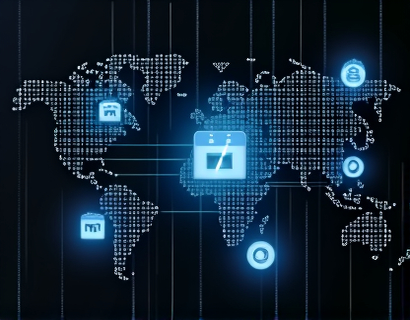Blockchain-Powered Asset Tokenization: Bridging Physical Assets with Digital Liquidity for Enhanced Market Accessibility
In the evolving landscape of finance and asset management, the integration of blockchain technology stands out as a transformative force. This technology, known for its role in cryptocurrencies, offers a robust framework for revolutionizing how real-world assets are managed and traded. By leveraging blockchain-driven tokenization, physical assets can be seamlessly integrated into a secure and transparent digital ecosystem, significantly enhancing liquidity and market accessibility for investors and asset holders. This article delves into the intricacies of this process, exploring how it redefines asset management and opens new avenues for investment.
Understanding Asset Tokenization
Asset tokenization is the process of converting rights to a physical or digital asset into a digital token on a blockchain. These tokens represent fractional ownership or specific rights associated with the underlying asset, such as real estate, art, or infrastructure. The tokenization process involves several key steps: identification of the asset, creation of a digital representation, issuance of tokens, and deployment on a blockchain platform. Each step is crucial in ensuring the token accurately reflects the value and characteristics of the asset it represents.
The primary advantage of tokenization lies in its ability to break down barriers to entry. Traditionally, high-value assets like real estate or art have been accessible only to a select few due to their substantial upfront costs. Tokenization democratizes access by allowing multiple investors to purchase fractions of these assets through tokens, thereby spreading the investment risk and making high-value investments more attainable.
Enhancing Liquidity through Tokenization
One of the most significant benefits of asset tokenization is the enhancement of liquidity. In traditional asset markets, selling a significant portion of an asset can be cumbersome and time-consuming. Tokenization changes this dynamic by enabling fractional ownership, which in turn increases the number of potential buyers and sellers. This liquidity improvement is particularly beneficial for illiquid assets, such as real estate, where transactions are often slow and involve substantial transaction costs.
For instance, consider a commercial property worth millions of dollars. Tokenizing this property allows multiple investors to purchase small fractions of the property, each represented by a token. This fractional ownership model not only lowers the entry barrier but also increases the overall market for these tokens, thereby enhancing liquidity. Investors can now buy, sell, and trade these tokens on various platforms, similar to stocks, making the asset market more dynamic and responsive.
Increasing Market Accessibility
Tokenization significantly broadens the scope of market accessibility. By converting physical assets into digital tokens, these assets can be traded on global markets, reaching a wider audience of investors. This global reach is facilitated by blockchain's decentralized nature, which eliminates the need for intermediaries such as banks and brokers. As a result, transaction costs are reduced, and the speed of transactions is increased.
Moreover, tokenization opens up opportunities for retail investors who previously lacked the capital to enter these markets. With the ability to invest in smaller, more manageable fractions of high-value assets, a broader demographic can participate in the investment ecosystem. This inclusivity fosters a more diverse and vibrant market, driving innovation and growth.
Security and Transparency in Asset Tokenization
Security and transparency are paramount in any financial transaction, and blockchain technology excels in these areas. The immutable nature of blockchain ensures that once a transaction is recorded, it cannot be altered or deleted. This feature provides a high level of security, reducing the risk of fraud and ensuring the integrity of the asset ownership records.
Transparency is another key benefit. All transactions involving tokenized assets are recorded on the blockchain, making them visible to all participants in the network. This level of transparency builds trust among investors and asset holders, as everyone can verify the ownership and transaction history of a token. Smart contracts, self-executing contracts with the terms directly written into code, further enhance this transparency by automating and enforcing the terms of the transaction without the need for intermediaries.
Case Studies and Real-World Applications
Several notable projects have successfully implemented asset tokenization, demonstrating its practical applications and benefits. One prominent example is RealT, a platform that tokenizes commercial real estate. RealT allows investors to buy, sell, and trade fractions of commercial properties using digital tokens on the Ethereum blockchain. This approach has not only increased liquidity for property owners but also provided investors with a new way to diversify their portfolios with real estate exposure.
Another example is the tokenization of art and collectibles. Platforms like SuperRare use blockchain to issue unique digital tokens representing ownership of rare art pieces. These tokens not only verify ownership but also provide a transparent and secure way to buy, sell, and trade art. This has opened new markets for artists and collectors, making the art market more accessible and efficient.
Challenges and Considerations
Despite its numerous advantages, asset tokenization is not without challenges. Regulatory uncertainty remains a significant hurdle, as different jurisdictions have varying approaches to blockchain and tokenized assets. Compliance with securities laws and anti-money laundering regulations is crucial to ensure the legitimacy and sustainability of tokenization projects.
Technical challenges also exist, such as scalability and interoperability. As the number of tokenized assets grows, blockchain networks must be able to handle increased transaction volumes without compromising speed or security. Additionally, ensuring that different blockchain platforms can work together seamlessly is essential for a cohesive and efficient market.
Future Prospects
The future of asset tokenization looks promising, with ongoing advancements in blockchain technology addressing current challenges. The development of more scalable and interoperable blockchain platforms, such as Polkadot and Cosmos, is set to enhance the capabilities of tokenized asset markets. These platforms aim to create a more connected and efficient ecosystem, facilitating the seamless transfer of assets across different blockchains.
Furthermore, the integration of other technologies, such as the Internet of Things (IoT) and artificial intelligence (AI), can further enrich the asset tokenization landscape. IoT can provide real-time data on asset performance, while AI can offer predictive analytics to help investors make informed decisions. These advancements will not only improve the functionality of tokenized assets but also attract more participants to the market.
Conclusion
Blockchain-powered asset tokenization represents a paradigm shift in how physical assets are managed and traded. By converting real-world assets into digital tokens, this technology enhances liquidity, increases market accessibility, and ensures security and transparency. While challenges remain, the ongoing evolution of blockchain technology and the support of innovative projects are paving the way for a more inclusive and dynamic asset market. As more investors and asset holders embrace this transformative approach, the potential for growth and innovation in asset management continues to expand.










































